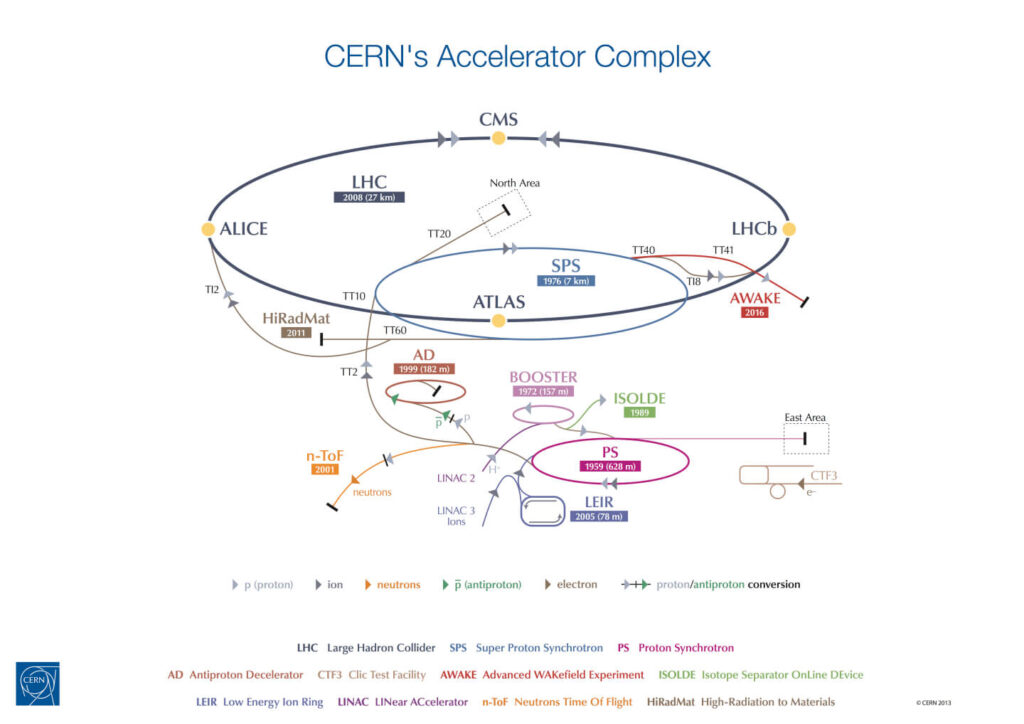X-Particles: Scientists at CERN’s Large Hadron CXollider in Switzerland were recently able to detect a vanishingly rare particle they believe was present at the beginning of time. For now, the particle is called an X particle since nobody knows exactly what it is. It was created by colliding billions of heavy ions inside the famous particle accelerator. CMS Collaboration scientists smashed lead atoms at 5.5 trillion degrees Celsius (9.9 trillion degrees Fahrenheit) at LHC’s Compact Muon Solenoid. They published their findings in Physical Review Letters. (Link given in References at the end of this article.)
- As per the review publsided, particle is referred as X(3872), also known as χc1 (3872).
- These exotic “X particles” at CERN were considered to be existed in the tiniest fractions of a second right after the Big Bang.
- In the first detection of X particles in quark-gluon plasma, scientists hope this will shed light on the particles’ as-yet-unknown structure.
To know more about this X particle from the dawn of time consider reading the entire article.
Suggested Reading – Standard Model of Particle Physics Simplified For You!
Table of Contents
What Exactly is X Particle?
According to physicists, the matter was formed by the fusion of subatomic particles, quarks and gluons, in a superheated soup shortly after the Big Bang. In fact, protons and neutrons didn’t form until the plasma cooled down after the Big Bang, paving the way for more dense forms of matter.) However, some of the quarks and gluons collided early on, creating some enigmatic particles known as X particles.
The universe is no longer dense or hot enough to produce X particles today.
Trending – Fundamental States of Matter – why there are so many states of matter?
Neutrons and protons, which are made of three closely bound quarks, are the basic building blocks of matter. It wasn’t until recently that physicists discovered tetraquarks – particles made from a rare combination of four quarks. According to scientists, X (3872) either consists of a compact tetraquark or a completely new type of molecule composed of two loosely bound mesons – subatomic particles derived from two quarks. Belle experiment in Japan discovered X (3872) in 2003 via bump hunting, when electrons and positrons were smashed together at high energy. In the study, the team found 100 X particles, called X(3872), which survived one-sextillionth of a second before decaying.
Check Lunar and Solar Eclipse Calendar 2022 – Know About 4 Eclplises of This Year
Discovery of Tetraquarks is a breakthrough in the history of particle physics experiments in the 21st century. Tetraquarks are exotic mesons that consist of four valence quarks. In quantum chromodynamics, the modern theory of strong interactions, it has long been suspected that a tetraquark state is possible. Tetraquark states are exotic hadrons that are outside the conventional class of quarks. Numerous types of tetraquarks have been observed. At last, in 2021, four more tetraquarks were discovered at the LHCb.
X Particles Discovery – What Happened at CERN’s Large Hadron Collider?
By accelerating 13 billion ions, the researchers were able to mimic the conditions of the early universe. CERN’s Large Hadron Collider (LHC) produces ionized quark-gluon plasma containing highly exotic particles created by collisions of heavy ions. Researchers searched for signs of X particles within the plasma. It was observed that these particles immediately broke down into “daughter” particles that scattered away.
Know About NASA Parker Solar Probe – Check Mission Details With Essential Information
Using a machine learning program, the researchers sorted through the extremely dense and noisy dataset to find the key variables that were likely associated with decaying X particles. Zooming in on the signals, they observed a peak at a specific mass, which indicated the presence of X (3872) particles.

Large Hadron Collider is the most powerful particle accelerator built to date. CERN, a European Organization for Nuclear Research located near the Franco-Swiss border near Geneva, Switzerland, houses the accelerator in a tunnel 100 meters underground. Using the LHC, protons or ions are accelerated to near the speed of light. The accelerator consists of a 27-kilometer ring of superconducting magnets and a variety of accelerating structures that boost the energy of the particles as they pass through them. Since its creation in the early 1970s, the Standard Model of particle physics has correctly predicted many phenomena and be able to explain almost all experimental results in particle physics. The Standard Model, however, is incomplete. The LHC is expected to provide answers to several of these questions.
Know Women’s Role in Science and Technology – Measuring Actual Success of Nation
Way Forward for X Particles
X(3872)’s identity is still unknown. According to the research team, the particle is either a type of loosely bound mesonic molecule (two subatomic particles called mesons bound via the strong force) or a tetraquark, a type of hadron made up of four quarks.
It may be that the upcoming runs of the LHC will reveal X(3872)’s identity. Once it has an actual name, it won’t be considered an X particle anymore.
References – Evidence for X(3872) in Pb-Pb Collisions and Studies of its Prompt Production at √ s N N = 5.02 TeV
X-Particles Discovery FAQs
X particle is a name given to a mysterious particle that was detected in Large Hadron Collider, it is believed to be formed moments after the big bang.
The X particle X (3872) was first discovered in Belle experiment in Japan in the year 2003 via bump hunting.
By recreating a condition similar to that of the early Universe scientists detected the X-particles. Scientists used quark-gluon plasma in LHC for this environment.
X (3872) either consists of a compact tetraquark or a completely new type of molecule composed of two loosely bound mesons – subatomic particles derived from two quarks.
Identifying the structure of X(3872) is the next task that will be studied.



0 Comments